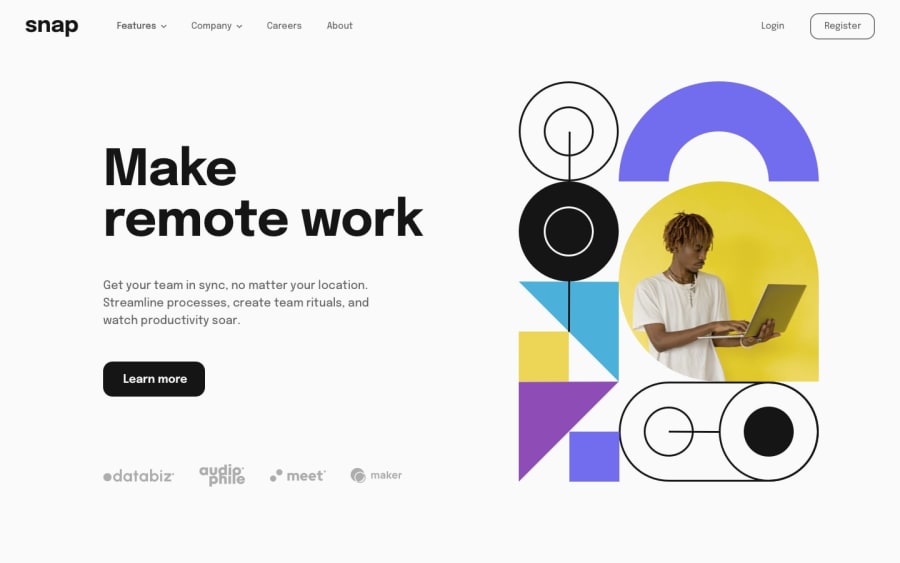
Design comparison
Solution retrospective
- svg, I needed to darken the dropdown arrow and end up using 'fill'. It filled the icon completely instead of just the arrows line. Is there another approach that could achieve this? Is it also best to use svg tags within the HTML file itself or as 'background-image' in CSS?
- Is it best practise to add media queries (CSS) after each class or handle all media queries at the end of a CSS file.
- The nav I handled by using JS to swap out CSS classes (top nav to side nav). The HTML wasn't changed, its structure contained within one HTML element. Is it better to separate the side and top nav structures into their own html tags?
- The picture HTML tag am still new to. Seems difficult contain the image size for responsiveness without stretching the image out or being too small.
Any feedback on this or anything else would be great. Thanks for viewing
Community feedback
- @aditya-chakrabortyPosted over 2 years ago
Hi @murray122,
Your CSS code looks pretty neat. But it is usually considered best practices to handle the responsiveness and put all the
mediaqueries at the end of the CSS file.Also, instead of using a different svg for each open and closed dropdown menu, you can consider using
transform: rotate(180deg)to rotate it by 180 degrees.Good job!
1@MURRAY122Posted over 2 years agoHi, @aditya-chakraborty Thanks for taking the time to give feedback, I used the 'transform: rotate(180deg)' mentioned and works perfect. Thanks again
0 - @Alejandro25ARPosted over 2 years ago
Hi @murray122,
- The svg is filled with black on the outside, since you must apply the property to the
strokeinstead offill. - It is better to embed the svg directly in the html than to place it as an image, since being in svg it can be resized without losing quality and its properties can be modified with css.
- I advise you not to change the
font-weingproperty when hovering the menu, as this increases the size of the box, causing a slight displacement of the other elements, which is not very pleasant visually.
Good work, keep it up
0@MURRAY122Posted over 2 years agoHi, @Alejandro25AR I liked the suggestion on the 'font-weight', much cleaner. The 'stroke' was also fixed, so thanks for the advice. Thanks for taking the time to give feedback and for the suggestion.
0 - The svg is filled with black on the outside, since you must apply the property to the
- @riccardofanoPosted over 2 years ago
Hello Murray, good job on the challenge!
Regarding your question about svgs: I personally use
<img src="picture.svg" />whenever I don't need to modify their color but I want them to take up space in the document so I can position them as you would with any other element in the dom.background-imageis used when I don't want it to occupy physical space, it just needs to be in the background.You can look at this blue Slack banner under the comments for reference, the first line is an
imgtag, while the dark blue logo in the bottom right corner is in abackground-image. One takes up physical space, the other does not.An inline
svgis for when you want to take up space and modify its properties with CSS, like your dropdown arrow. Depending on how the svg was made you'll want to modify either thefillor thestroke, you can look at the actual file to know for sure.<svg class="icon" width="10" height="6" xmlns="http://www.w3.org/2000/svg"> <path stroke="#686868" stroke-width="1.5" fill="none" d="m1 1 4 4 4-4"></path> </svg>As you can see the
strokeis a color while thefillisnoneso in this case you'll want to modify the stroke.0@MURRAY122Posted over 2 years agoHi @riccardofano, I was able to fix it by changing the 'stroke' properties. Thanks for taking the time to give feedback and for the knowledge.
0
Please log in to post a comment
Log in with GitHubJoin our Discord community
Join thousands of Frontend Mentor community members taking the challenges, sharing resources, helping each other, and chatting about all things front-end!
Join our Discord
